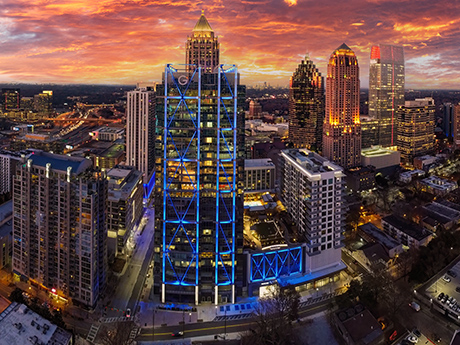Atlanta’s next retail boom is being driven by Millennial demand.
Developers and investors are witnessing a trend that Atlanta retail activity is quickly expanding to its outer suburbs, fueling a new chapter of growth for the market.
“There’s a lot of momentum and growth happening, not just in the city of Atlanta, but when you really start looking at the MSA as a whole,” says Michael Berk, vice president of SRS Real Estate Partners. “The thing about Georgia and Atlanta is there’s no natural boundary that will inhibit growth.”
Berk explains that the migration of residents has reshaped the region’s retail real estate landscape “outside the perimeter,” whereas at one point in time, urban cores “inside the perimeter” like Downtown, West Midtown, Midtown and Summerhill were the primary focus for retail due to high foot traffic and dense populations. The “perimeter” is Interstate 285, a ring road running around the city.
Sources interviewed for this article say that intown property development has become scarcer due to rising interest rates and construction costs, as well as the increased competition for a limited supply of land — which is ultimately pushing developers outward. Several real estate firms have reported that retail construction in the city has dropped more than 40 percent since the second quarter of 2024, and by May 2025, the amount of retail space was the lowest on record.
Not to mention, the heavy investments by auto manufacturers in Georgia are driving economic and business attraction efforts to the outskirts, too. Rivian held a groundbreaking for its $5 billion electric vehicle (EV) manufacturing facility in the Social Circle area, which sits east of Atlanta via Interstate 20 near Covington. As Atlantans seek more affordable homes, schools with improved educational outcomes for students and a different quality of life outside the city, suburban submarkets are becoming hotspots for retail expansion, redistributing both consumer dollars and developer interest across a much broader geographic footprint.
“From Cobb, Fulton and DeKalb Counties, to Gwinnett and Forsyth Counties, where the residents go, these retailers will follow,” says Berk.
Redefining the Suburban Experience
As the largest generation in the U.S. workforce and a major driver in household formation according to the U.S. Department of Labor, millennials have had a profound impact on real estate development since the mid-2000s. While this generation once fueled urban core growth, a notable shift has occurred in the past several years, undoubtedly aided by the COVID-19 pandemic. Many millennials are moving to the suburbs — and bringing their urban lifestyle expectations with them.
“Everybody wants to redevelop their downtowns — or build a downtown — because that’s what the millennials want,” says Lynn McKee, director of the Master of Science commercial real estate program at Georgia State University. “That [concept] is absolutely exploding right now in almost all of the major downtowns in suburban Atlanta.”
Unlike previous generations, millennials aren’t drawn to traditional, car-dependent suburbia. Instead, they want walkability, convenience and community.
“They [millennials] want to be able to go to the town green and watch a concert or go to a restaurant, while there’s also a big playground there for their kids. People are choosing to go to mixed-use places because it’s exciting,” McKee continued.
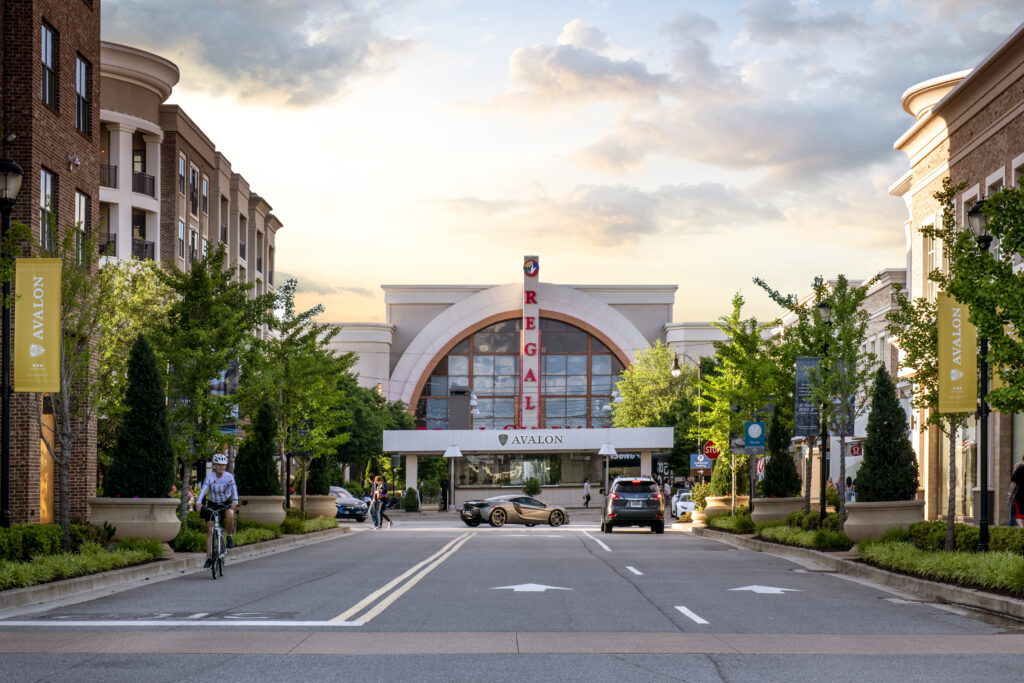
In response to these desires, developers are reimagining suburban downtowns in the northern neighborhoods of Atlanta with vibrant, mixed-use destinations that blend residential, retail, dining and public space. Properties like Alpharetta’s Avalon, Avenue East Cobb in Marietta and Johns Creek’s Medley are fueling retail growth outside Atlanta city limits.
Launched in 2016, Avalon, a $1 billion master-planned mixed-use development now firmly bedded in Alpharetta’s landscape, stands as a transformative model for suburban development. Known as the South’s first “urbanburb,” Avalon has blended an array of offerings across 2.3 million square feet that has redefined local real estate standards while also inspiring similar developments both regionally and nationally.
The suburbs continue to be a huge growth vehicle for Atlanta, as Kimberly Goetz, vice president of leasing at Toro Development Co. (TDC), emphasizes that the wealth, density and expansion found outside the city is highly appealing for ground-up developments; however, a focus on community is what drew her firm to the suburbs in the first place.
“We like to say we’re not developers, but that instead, we’re community builders. People really buy into it because they want to be a part of it, they believe in it and they want to add to their community,” says Goetz.
Upon completion, Medley, TDC’s $560 million mixed-use development in Johns Creek, will span 43 acres and is designed to serve as the “third place” at the heart of the metro area’s emerging city center. Built on the former State Farm office campus, Medley is a cultural and economic catalyst that is establishing a hub for community life that combines retail, living, working, dining and events all in one place.
“We are offering that human energy, feet on the street and that concierge hospitality that a lot of shopping centers don’t offer,” continued Goetz. “We want people to feel like they can linger at Medley, whether that’s buying a baby gift or athletic wear or just staying to peruse.”
Goetz adds that health, beauty, fitness and wellness-oriented tenants are popular among consumers, not just for their own communities, but for Atlanta’s retail scene in general.
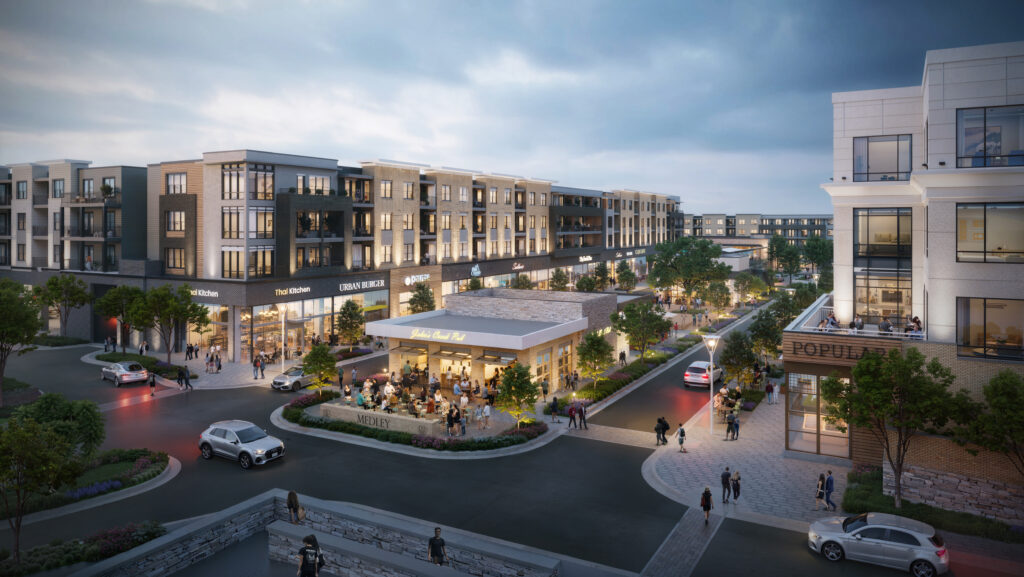
“We have a whole service corridor dedicated to that [at Medley] — it’s everything that you need to just feel great.”
Currently expected in late 2026, the first openings at Medley will feature a mix of retail, restaurant and service-driven options such as Minnie Olivia, 26 Thai Kitchen and Bar, Sugarcoat Beauty, Dry Bar Shops, BODYROK, Fadó Irish Pub, Cookie Fix, Sephora and Rena’s Italian Fishery & Grill, to name a few.
“Johns Creek is just ripe and ready for a mixed-use place, like what we’ve created, and there’s still more opportunity for that,” says Goetz.
Similarly, Avenue East Cobb, a 230,000-square-foot redeveloped lifestyle destination managed by Jamestown, has blended retail, restaurants and community gathering space within an open-air setting to underscore that reinvented “downtown” feeling that encourages residents to walk, browse and dwell. Avenue East Cobb welcomed Round Trip Brewing Co. to its development last year, which included a 4,500-square-foot tap room, indoor and outdoor drinking areas, a private event space and a food stall.
Halcyon, a 135-acre mixed-use “village” in Forsyth County opened its first phase in late 2019, with offerings like boutiques, chef-driven restaurants, office space, a food hall, dine-in movie theater, luxury multifamily and seniors housing, as well as single-family homes. With a strong placemaking focus, the community serves as the trailhead for the Big Creek Greenway, fusing nature trails with an urban environment.
Although still expanding, Halcyon is fully operational and has recently signed Trader Joe’s — which will join a mix of other new retailers in its third phase such as Chick-fil-A, Five Guys and Chase Bank.
The Gathering, which will also be located in South Forsyth County, is a planned ground-up project that is anticipated to become a major mixed-use entertainment district. Designed with an 18,000-seat arena as its centerpiece, The Gathering has proposed 1.6 million square feet of retail and office space, residential units, hotels, infrastructure for a fire department and sheriff’s precinct station and a 1.2-mile addition to the Big Creek Greenway trail system. The $3 billion venture is being phased over several years as a means to generate economic growth for the community, as well as to possibly bring a new National Hockey League (NHL) franchise back to the metro Atlanta area.
Meanwhile, roughly one mile from Avalon, there are plans to convert the 1980s-era Brookside Office Park into a vibrant mixed-use neighborhood with apartments, townhomes and retail space. Portman Holdings acquired the 20-acre site this past August with goals to create a walkable destination for residents and community members, including a dozen acres of green space. Construction on the project is slated to begin in summer 2026.
Lakeshore Mall, a 1970s regional shopping center approximately 55 miles northeast of Atlanta in Gainesville, Georgia, is yet another unique rendition of the suburban segue to mixed-use developments. Branch Properties will lead the multi-phase renovation of the property, now dubbed Lakeshore, to encompass an accessible, open-air location that functions as both a residential hub and communal gathering place. Upon full build-out, Lakeshore will feature 652 residential units, 38,200 square feet of green space and 305,000 square feet of retail.
Breathing New Life into the City
Ground-up developments often bring an energy of revitalization and can reshape a community by meeting the evolving needs of consumer demand, but launching these new ground-up projects has become tainted with obstacles such as the rising costs of construction, tighter financing and market saturation.
“Overall economic uncertainty, ranging from interest rates to inflation, has impacted not only developers, but also consumers,” says Mindy Selig, co-owner and senior vice president of retail leasing at Atlanta-based Selig Enterprises.
However, amidst the current market struggles, Atlanta is powering ahead with retail and mixed-use projects by not only breaking ground, but also by reshaping the urban core to restore economic momentum.
“There are plenty of areas that are suffering from a lack of growth, but Atlanta continues to be a hot place where retailers from across the country want to come and grow, and seeing these new projects come on line is extremely important,” says Greg Eisenman, regional managing director of Franklin Street’s Atlanta office.
Centennial Yards, a $5 billion megaproject in a once-blighted 50 acres of downtown formerly known as The Gulch, is more than just another development for the city of Atlanta. Led by CIM Group and a development entity called Centennial Yard Co., the project is turning underused rail yards into a master-planned district featuring housing, hotels, retail, entertainment and a Live Nation-leased, 5,300-seat venue set to open in 2027, filling the void in downtown’s most neglected corner.
Spanning nearly 8 million square feet upon completion, Centennial Yards is creating an entirely new commercial ecosystem for the city centered on sports and entertainment. The development is designed around pedestrian-centric spaces and public plazas with enhanced connectivity to MARTA (Atlanta’s mass transit system) and the Atlanta BeltLine (the city’s urban trail network currently underway), unlocking previously inaccessible land and stitching together east and west Atlanta.
Meanwhile, additional redevelopments in Atlanta’s promising downtown scene are continuing to revolutionize how Atlantans live, work and shop. The Center, CNN’s former headquarters, is being repurposed by CP Group into a 1.2 million-square-foot mixed-use complex that is slated to open before the 2026 FIFA World Cup, games of which will be played at the adjacent Mercedes-Benz Stadium.
The continued expansion of the Atlanta BeltLine, a trail system that will one day circle the city’s core, paired with MARTA’s upcoming 5-mile Bus Rapid Transit (BRT) line that connects downtown Atlanta to the Capitol Gateway, Summerhill, Peoplestown and the BeltLine’s Southside Trail, further propels the city ahead in a transit-oriented environment — fueling housing, retail and office growth around pedestrian-friendly corridors.
One of the more ambitious redevelopments along the BeltLine is Jamestown’s Ponce City Market in the city’s Old Fourth Ward neighborhood. Opened in 2015 and ever-evolving, Ponce City Market is another transformative example of how residential, commercial, office and retail can coexist in a human-scaled environment.
“At Jamestown, we’re not building commodity centers. We’re curating destinations to be ‘sticky’ — meaning we stack experiences from shopping to dining to community-driven events with the intention of extending dwell times,” explains Adam Schwegman, director and head of retail leasing at Jamestown.
Situated along the Eastside Trail of the BeltLine, Ponce City Market has been designed as an avenue for tourism and consumer spending in a once underutilized part of the city. The success of this project, among others like it, validated the BeltLine’s vision of mixed-use connectivity and spurred investments in various surrounding neighborhoods, emphasizing their positions as premier destinations for both shopping and dining.
Not only is downtown Atlanta reinventing itself with large-scale, mixed-use creations, but other urban localities around the city are experiencing rapid expansion, too.
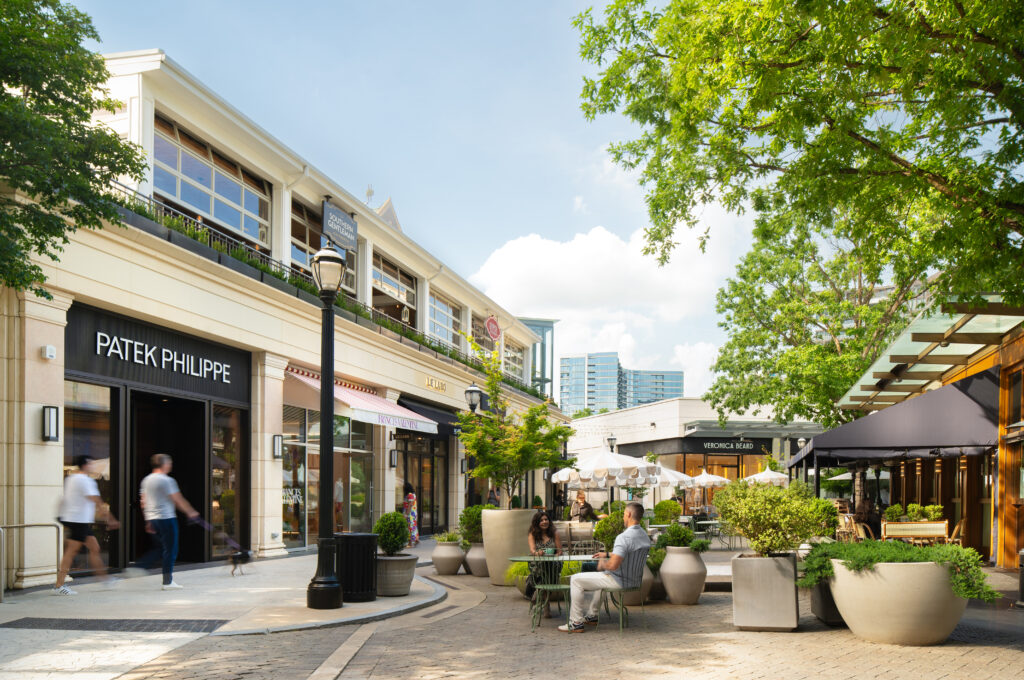
“Atlanta is continually experiencing broad-based retail activity across the market, where Midtown, Westside and Buckhead are drawing high-end retailers and restaurants,” states Fraser Gough, retail leasing and property management specialist at Partners Real Estate.
For example, The Works, Selig’s adaptive mixed-use district that opened in 2021 in Atlanta’s Upper Westside neighborhood, features 500,000 square feet of fully leased office space and will include 350,000 square feet of retail, restaurant and entertainment offerings, as well as 500 residences and a hotel, upon full build-out. Restaurants and retailers that already call The Works its home are Woof Gang Bakery & Grooming, Chicheria Mexican Kitchen, Dr. Scofflaw’s, Adelina Social Goods, Patty & Frank’s and Swan Space.
In recent years, Selig has been primarily focused on Atlanta’s intown neighborhoods because of their locations near major highways, dense populations and trail connectivity. Regardless of these factors, as land becomes more limited, demand is, once again, rising in adjacent markets outside the immediate city limits.
Subsequently, Simon Property Group — owner and operator of Atlanta’s Lenox Square — recently introduced 18 new tenants to the 1.5 million-square-foot super-regional mall to keep the center relevant while also appealing to the evolving customer base, which includes both Gen Z and Millennial shoppers alike.
When One Door Closes, Another Opens
The sudden wave of big-box closures, including Party City, Big Lots and JOANN has created a noticeable softening in Atlanta’s retail real estate market. Retail availability has risen for two consecutive quarters, but when compared to historical vacancy levels, the market remains well-leased overall. Vacancy rates hover around roughly 4.1 percent and retail has outperformed the 10-year average of 5.5 percent vacancy, according to a second-quarter retail report by Matthews Real Estate.
With longstanding tenants vacating sizable footprints in high-traffic corridors and suburban shopping centers, landlords are being pushed to rethink and reposition their properties.
“Releasing these spaces is challenging because many are located in markets or have footprints that don’t fit with the current needs for junior-box retailers,” says Matthew Oppenheimer, president of Atlanta-
based Halpern Enterprises. “Not to mention, rising construction costs in recent years have made backfilling these spaces more expensive, which in turn has created tougher economics for both landlords and tenants.”
Yet, this challenge has also opened the door for new opportunities.
“As a landlord, it’s scary when there’s a little bit of vacancy rise, but at the same time, it’s a good chance for them to improve the rents and credit in their shopping centers,” says Eisenman of Franklin Street. “If you’re doing a good job in your center and you’re putting in the right tenants, you’re bringing more people in, and that makes it attractive to higher-credit tenants.”
Sources have reported a mixed bag of results regarding the trends of leasing activity in Atlanta’s retail landscape, but nonetheless, new property vacancies are creating opportunities for tenants to lease second-generation spaces.
“When landlords strategically replace legacy concepts to elevate the tenant mix, they’re ensuring that centers remain relevant and aligned with consumer preferences,” says Benton Green, retail leasing and property management specialist at Partners Real Estate.
And as the cyclical shift of big-box closures becomes more prominent, brokers and landlords are restructuring these spaces to meet the needs of the community through boutique fitness, specialty grocers, pet stores or service-oriented tenants, creating a more diverse and dynamic tenant mix.
Another notable trend is the growth of medtail, or medical tenants, that are leasing space in neighborhood shopping centers. Medical tenants are increasingly attracted to established retail environments that fulfill patient demand for better accessibility and convenience.
Pickleball facilities are also progressively being used to backfill large, empty anchor spaces in malls and shopping centers, while the TJX-branded HomeSense and Sierra retail concepts — which are not fully rolled out in Georgia yet — are using these closings as a chance to find locations for their up-and-coming stores.
Oppenheimer shared how his firm has transformed several different spaces across Georgia, such as dividing a 32,000-square-foot grocery store into two new stores for Marshalls and Ulta Beauty, converting a former 18,000-square-foot antique store into another new Marshalls, as well as remodeling a former CVS Pharmacy into a Five Below.
“Although rising costs have made these deals more challenging, strong tenant demand and creative dealmaking are keeping these projects moving forward throughout the region,” says Oppenheimer.
The closures of big-box retail enable a more flexible and adaptive retail landscape in Atlanta, and according to Eisenman, filling vacant properties with innovative, strategic solutions is a key driver for helping Franklin Street’s retail clients reach their growth goals.
“From our standpoint, if we can help a landlord bring people into a shopping center, we’ll also help all of the other tenants that are there,” continues Eisenman.
Zach Taylor, senior managing director of Marcus & Millichap’s Taylor McMinn Retail Group in Atlanta who primarily focuses on shopping center sales, adds that “as more deals are starting to pencil, a modest decrease in interest rates could unlock a wave of listings and trades.”
As strongly anticipated by investors and financial analysts, the Federal Reserve, through its Federal Open Market Committee (FOMC), cut the benchmark interest rate by 25 basis points in September, while signaling a possibility for two more quarter-point rate cuts this year. This marks the first rate cut to the federal funds rate since December 2024.
Don McMinn, also with the Taylor McMinn Retail Group, notes that net lease tenants — such as Whataburger, McDonald’s, Starbucks Coffee, Chipotle Mexican Grill and Chick-fil-A — are driving substantial investor demand by increasing transaction activity and solidifying the city’s role in regional and national retail real estate investing.
According to McMinn’s experience, transaction volume has increased year-over-year by 27 percent, with a 33 percent expansion of the 1031 buyer pool and a 25 percent decrease of days-on-market, maintaining the indication of a competitive market with high demand.
Tenant Mix Matters
The concept of experiential retail has recently propagated the resilience of Atlanta’s retail sector, as a result of both post-pandemic behavior and the exploding interest of mixed-use developments for investors. Retail spaces are now frequently designated to offer consumers more than just products — developments are encouraging longer visits, more brand engagement and emotional connection, allowing people to gravitate toward spaces that are immersive, interactive and entertainment-driven.
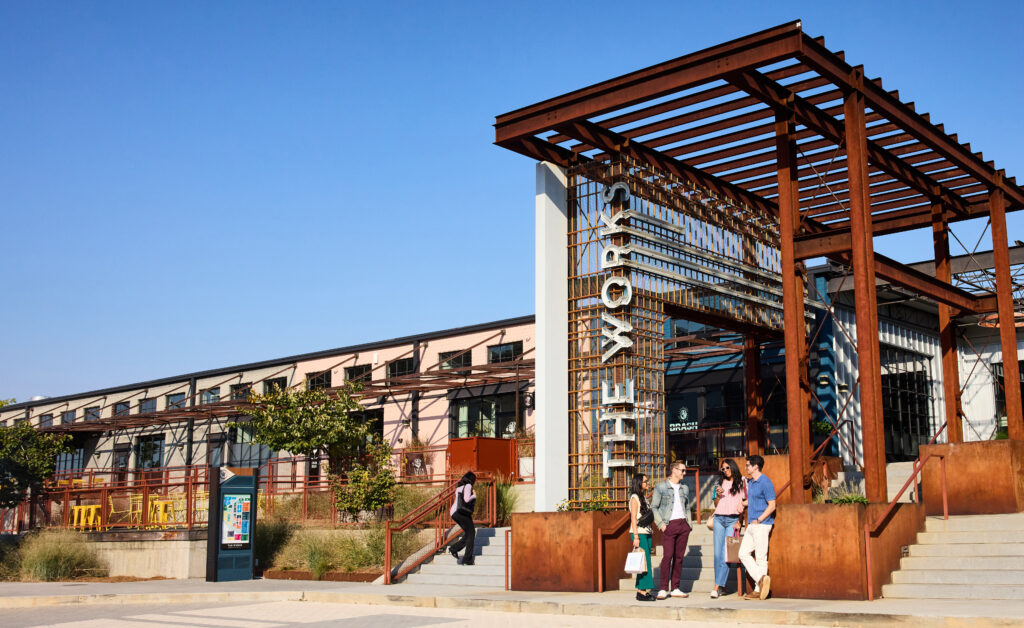
One of the primary hurdles facing landlords is curating a tenant mix that matches the surrounding environment as developers make the shift toward experience-driven concepts.
“Location is one of the most important factors for retailers,” says Selig. “Premium locations demand premium rents, and this is quantified by trade areas that demonstrate density and a strong consumer base.”
Selig also mentions additional elements that impact the success of tenants, such as visibility, surrounding infrastructure and community resources, as well as neighboring businesses like hotels, universities and Class A office space.
In addition, GSU’s McKee emphasizes that bringing in new tenants requires great demographics, accessibility, adequate parking and efficient management.
“If you’re missing any of those [factors], it’s going to be difficult,” continues McKee.
Furthermore, retaining tenants in retail real estate is critical for maintaining consistent cash flow, reducing turnover costs and enhancing the value of your property.
Leo Weiner, president of Ackerman Retail, the retail division of Ackerman & Co., asserts that placemaking and fulfilling the unmet needs of shopping centers are key pieces of the puzzle for attracting both tenants and landlords.
“The first course of action is proactive management — making sure you understand the tenants’ needs and wants, and trying to keep them,” says Weiner. “Then, by carefully thinking through the merchandising of your property and making sure you have co-tenants that will drive customers to your centers, your tenants are able to capitalize on those opportunities.”
Ackerman & Co. has remodeled 22 acres of former obsolete industrial warehouse space into a large-scale adaptive-reuse project in Atlanta’s historic West End neighborhood. The project, called Lee + White, incorporates a blend of dining, breweries, entertainment, creative office space and a “container village” dedicated to startups and small businesses.
“Developing [Lee + White] was just a matter of finding a need in markets that did not have a lot of supply and bringing what customers wanted. In doing so, as a result, we’re now pending one large office lease, and then we’ll be stabilized and fully occupied.”
Schwegman explains that Jamestown’s leasing strategy is focused on building partnerships to better understand their tenants’ occupancy costs, their overall business segment and if sales are trending in the right direction.
“These data points inform our decision to either begin looking for a new tenant or to spend time figuring out the next five years together.”
With limited new inventory coming on line throughout the competitive retail scene of Atlanta, it’s even more valuable now to retain existing tenants.
“Overall, Atlanta remains one of the strongest retail markets in the country, and we’re confident it will continue to offer meaningful opportunities for both landlords and tenants,” says Halpern’s Oppenheimer.
The Next Step
Even as the broader economic uncertainty has slowed transaction velocity, sources say that Atlanta’s status as a destination for retail real estate has strengthened substantially, with a mighty appetite to keep growing.
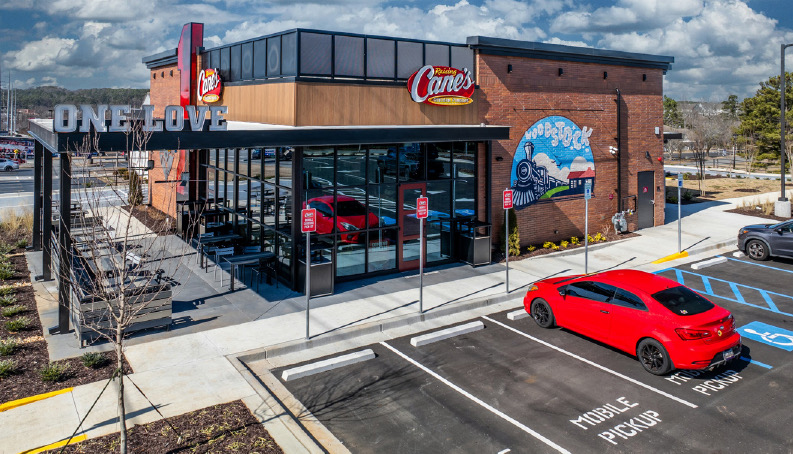
“The various projects spanning from downtown Atlanta to the suburbs are signaling a new wave of retail investment and placemaking,” highlights Jacob Harb, retail leasing associate at Partners Real Estate.
“[At Ackerman & Co.], we’re extremely optimistic about metro Atlanta’s opportunities for us and anybody else willing to take some risks in the city,” states Weiner.
Overall, Atlanta’s retail real estate market continues to show strong performance across several key indicators. Construction activity remains strong in suburban and intown submarkets, with developers often targeting infill locations and adaptive reuse opportunities that appeal to the modern consumer. Meanwhile, landlords and developers are curating their tenant mix to prioritize experience-driven offerings, from restaurants to fitness to pop-up activations, while also competing for spaces in a walkable, amenity-rich environment.
Berk of SRS adds that, “With the growth that can happen in Atlanta and Georgia as a whole, there’s a great amount of longevity still out there for landlord and tenant reps, as well as somebody who’s in project leasing or investment sales, because there’s just so many more deals to be done around the state.”
Retail in Atlanta is no longer just about shopping — it’s about creating places that influence people to linger, connect and return.
“You can’t buy an experience on Amazon, so what everyone is trying to do is make their place special and somewhere that people want to go to,” concludes GSU’s McKee.
— Abby Cox
This article was originally published in the October 2025 issue of Shopping Center Business magazine.


